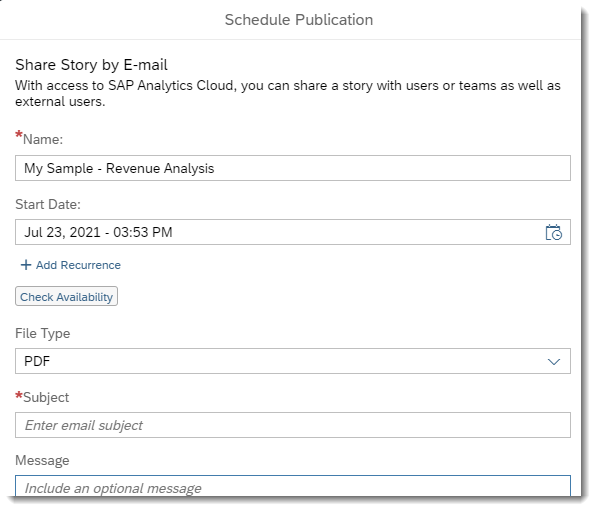Learn How to Share and Collaborate in SAP Analytics Cloud
Get an overview of sharing and collaboration, and learn different ways you can share your analytics content with colleagues and collaborate with them on it.
Who does this apply to?
- Users who have the Share permission for any data objects.
- Users who have the Create or Manage permission for Schedule Publication.
- Users who have the Execute permission for Publish Content.
Ways You Can Share and Collaborate
When you've created some valuable content, like an informative story or boardroom presentation, you might want to share it with others so they can benefit from the information too, or contribute to it.
SAP Analytics Cloud provides a few ways of sharing and collaborating:
Invite other users or teams to have a look at some content
There are many reasons for sharing your content with others. For example, you might want to show your forecasts to decision makers in your organization, or you might have developed a great analytic application that you want your team to use.
Here are a few options:
- You can publish your content to the Catalog.
The Catalog is a tab on the Home screen that users can publish content to so that other users or team members have a single location where they can discover relevant content.
Within a workspace, you can publish content to the teams within the workspace.
Publish and Share Content to the Catalog

- You can send files, folders, stories, bookmarks, and analytic applications directly to
users.
They'll receive notifications, which they can click to open the shared content.

Keep all of your team's content in one place, separate from other teams' content
Especially in larger organizations with many users and a lot of content, it can be challenging to organize and manage the content, or to restrict access (for example, for HR or Finance data).
- You can organize your content in Workspaces.
Workspaces are virtual spaces that an SAP Analytics Cloud administrator can set up to mimic your organization's departments, LOBs, regional structure setup, or any other organizational setup. Workspaces let you organize content for access by different teams of users. You share and collaborate on content within the confines of the workspace.
Share and Collaborate Within Workspaces

Ask other users to work with you on your content
Collaboration features let you invite others to contribute their ideas or data to your work, or you might just want to run your content by your peers for feedback.
Here are a few options:
- You can invite other users to a discussion.
Using discussions, collaboration activity is grouped together in discussion threads.
Collaborate by Having Group Discussions

- You and your team can add comments to specific pages or widgets within a story.
Other users can reply or
 Like your comments.
Like your comments.Collaborate by Adding Comments to Stories

- You can add a comment widget to your story.
The comment widget lets you add comments related to your data, and also displays data point comments.
Adding Comment Widgets to Your Story

Send content to users on a daily, weekly, or monthly basis
If people depend on you for regular updates with the latest information, you might want to take advantage of the scheduling feature so that they automatically and reliably get that information.
- You can set up a schedule to periodically deliver content, such as stories or analytic
applications, to a group of users.

Send content to others, so they can import the data into another application
SAP Analytics Cloud has many analysis and presentation features, but some of your colleagues might prefer to use different tools, like Excel, PowerPoint, or Google Slides. It's easy to export your data to other formats, like comma-separated-values (CSV) or PDF, for use with those applications.
It's nice to share, but be careful with your data
When you share content, you'll want to be sure that the users you're sharing your content with have the appropriate access to the content. For example, you might want some users to have only Read access so they can't make any changes. For others, you'll want to give them Update access so they can make changes to suit their line of business.
Another thing to keep in mind: when you share content with other users, do you want them to be able to re-share your content? If so, you'll need to grant them sharing permission for the content, in addition to initially sharing the content with them. For more information, see Share Files or Folders.